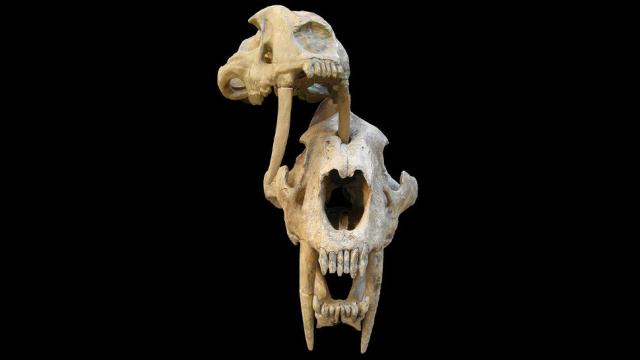An analysis of two punctured sabre-toothed cat skulls suggests these extinct creatures engaged in intra-species combat. It’s further evidence that the exaggerated fangs of sabre-toothed cats were strong enough to penetrate bone.
Sabre-toothed cats disappeared around 11,000 years ago, but these fearsome predators dominated Pleistocene landscapes for millions of years.
The purpose of their iconic fangs, however, is the subject of a longstanding debate, with some scientists arguing that the fangs — which grew as long as 28cm in length — were too fragile, and the sabre-tooth bite too weak, to be used for attacking prey.
According to this theory, the fangs were only put to use once a sabre-toothed cat brought its prey down to the ground with its huge forelimbs, at which point the elongated upper canines were used to pierce through the soft, vulnerable neck.
New research published in the science journal Comptes Rendus Palevol now presents a serious challenge to this scenario. A pair of sabre-tooth skulls, both belonging to the species Smilodon populator, exhibited puncture marks consistent with a bite inflicted by a member of the same species.
The finding suggests sabre-toothed fangs were indeed strong enough to penetrate bone, while shedding new light onto their social behaviour, namely that sabre-toothed cats fought amongst themselves.
The authors of the new study, led by Nicolás Chimentoa and Federico Agnolin from the Natural Sciences Museum of Argentina, theorise that the ancient cats engaged in intra-species combat, similar to modern felines.
Analysis of the two punctures (one on each skull) revealed a distinctly elliptical shape. Each hole was located on the upper nasal area between the eyes, and they were slightly sunken in, suggesting pressure was exerted onto the skulls. One of the specimens showed signs of healing, which meant the individual survived for a long time after enduring the injury.
“The size and general contours of the injuries present in [the] specimens… are consistent with the size and contours observed in the upper canines of Smilodon,” the authors wrote. “In fact, when a blade-like upper canine of a Smilodon specimen is inserted through the described opening, both perfectly match in size and shape.”
Based on the shape of the holes, the authors said it’s unlikely — but not impossible — that the punctures were caused by the kicking action of a hoofed prey animal, which have anywhere from two to four toes.
The holes also didn’t match the shape of teeth from other predators, such as bears — an animal that would have created a discernibly roundish puncture wound. The researchers also said it’s unlikely the punctures were caused by a large-clawed giant ground sloth, as its claws “should have resulted in very different injuries from those reported here,” the authors wrote.
The “shape and general features of the injuries suggest that they were inflicted by the upper canines of another Smilodon individual during [antagonistic] interactions,” concluded the authors.
Importantly, similar injuries are often seen in living felines, including leopards, pumas, cheetahs and panthers. Such injuries, the authors wrote, are often the result of violent encounters between males and sometimes females, and they frequently result in the death of one of the participants.
The new study suggests the same sort of thing occurred among the sabre-toothed cats, but that remains speculation.
It’s pretty amazing what can be gleaned from a couple of holes. This evidence suggests that sabre-toothed cats could possibly have used their bone-penetrating fangs to take down prey. And indeed, this is not a completely wild assertion; previous fossil evidence has already hinted that sabre-toothed cats hunted the giant armadillo-like glyptodonts in this fashion.
We always knew sabre-toothed cats were intimidating, but this paper — along with the striking skulls image above — suddenly makes them seem a lot more terrifying.
